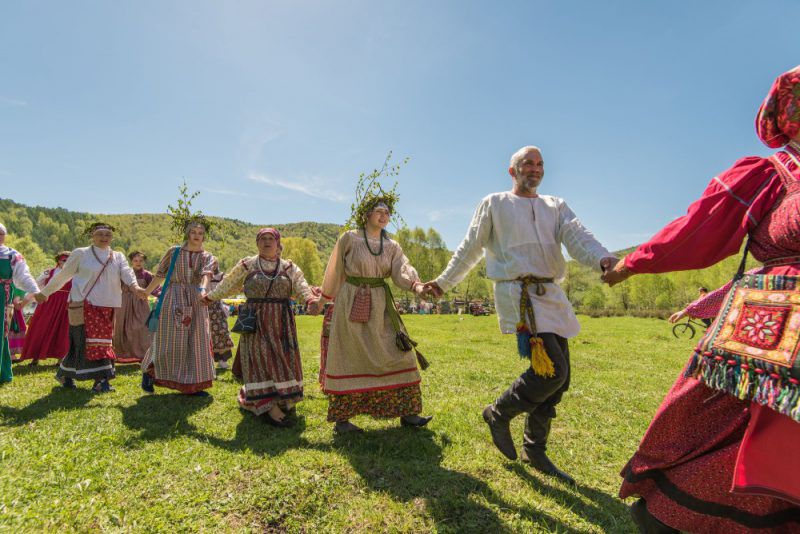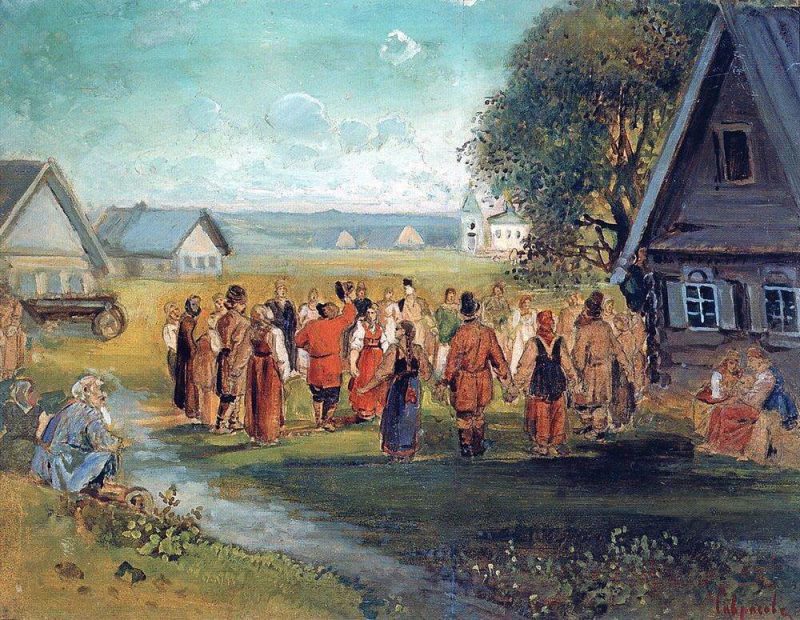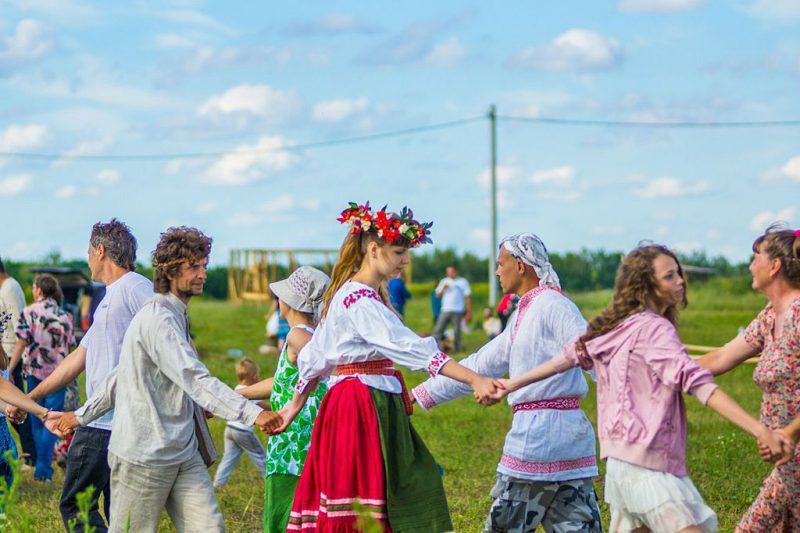Khorovod – Folk Russian dance: Walking following the sun
Folk dance is a reflection of the life, mood and culture of people. The Russian people, throughout their centuries-old history have created a lot of wise fairy tales, wonderful ornaments reflected in the handicrafts, many rich in content and rhythmic songs. Besides, they have been very creative in dancing content. The Russian khorovod is a true masterpiece of dance art.

Khorovod is not only the most widespread, but also the most ancient type of Russian dance. However, who and when was the first in Russia to dance remains unknown. The basic circular structure and movement of the khorovod originate from the ancient pagan rituals of worshiping the god of the sun Yarila.
There are not many other elements of national culture that would consistently play such an important role over the centuries. Vladimir Dal, Russian writer, ethnographer, lexicographer, and collector of folklore described khorovod as a “rural youth meeting in free air to dance with songs”.
Dancing is a leisure activity, and therefore there was a special time to start a khorovod. In the spring, people were playing the game “Stream” – a symbol of melting snow. In paganism, the first spring khorovods appealed to the gods of fertility. Holding hands, participants climbed the hills, devoting the dance to Mother Earth and calling spring. In July, they praised Kupala (Ivan Kupala is the Eastern Slavic folk festival dedicated to the summer solstice) and making a khorovod around the fire and with wreaths, they asked for the ripening of fruits. In honor of another character of Slavic mythology – Bereginya – the khorovod was made around a birch tree that symbolized the cleanliness and considered to be the patroness of family and earth.
With the adoption of Christianity, khorovods in rural areas were started at the times when there was no Lent and work in the fields.

How the dance would start
Often the dance began when two or three girls living next door stood in the middle of a street and began to “play songs”. They were gradually joined by other girls and young men. The guys came often with musical instruments including violins and tambourines. As a rule, in the center of the khorovod there was a khorovodnitsa – the most lively woman in the village. She would be the choreographer and choir performer by vocation – she would start the songs and invent new dance patterns.
Sometimes khorovod started differently: on a holiday at the fair, several girls first slowly began to sing humorous songs; the guys would be singing along or playing some musical instruments. Then everyone got up and, holding hands, made a circle. Then one of the girls would start to sing loudly, and a guy would come in the middle of the circle with a handkerchief in his hand. A khorovod song would begin, accompanied by a pantomime inside the circle.
Khorovod in the life of the people
Girls were always a moving force of the khorovod. For them it was also a way to show themselves and to choose a future husband. Girls used to start participating in the khorovod quite early, at 12 or 13 years old, but it was not always the age that would define that. When there were a few sisters in a family, the advantage of participation was first given to the eldest daughter, until she would get married. Then there came the turn of her younger sisters.
Khorovod has always been an event in the life of the Russian people. Women and girls, preparing for the dance, used to put on the best dresses. Girls used to buy ribbons and scarves at fairs, or often weaved, sewed, and knitted them themselves. Men in round dances represented the guests invited to share the joy. Young unmarried guys entered the games with the girls at the invitation of the khorovodnitsa – each of the guys was looking for a bride among the dancing elegant girls. The girls were not behind and watched: who of the guy was looking more closely, who would come up and call to play a lively game.
Dance patterns
You can always feel a sense of unity and friendship in the khorovod. Participants hold hands, sometimes with one finger, sometimes they hold a scarf or shawl. In some khorovods, participants move one after the other, maintaining a strict interval. The composition of the khorovod depends in the region, each of them adds something of its own, creating diversity in style, character and manner of performance.
For example, in the northern parts of Russia, khorovods have always been distinguished by dignity, calmness, composure and surprising musicality, as if they feature the strict beauty of the North and the unchanging temperament of the Russian soul. At the same time, it’s hard to convey all their emotional richness and depth.
Near Moscow, khorovods were rather joyful and light-hearted, accompanied by amazing songs, clapping hands, tapping, fast and vigorous movements.
The closer the region to the South, the more impetuous and daring the khorovods were, sometimes turning into other types of dance and distinguished by an intricate pattern and crowdedness.
In terms of content, character, form, and time, Russian khorovods were divided into four seasonal groups: spring, summer, autumn, and winter ones. Khorovods could be closed (circular) and open (rows, snake, zigzags, etc.). Sometimes the dancers from a circle inside a circle, sometimes two circles side by side, and sometimes these circles overflow one into another and form the figure of the eight. Large circles and small circles are a very common form of Russian khorovods. Each khorovod pattern has its own name, for example: “circle”, “gate”, “eight”, “column”, “basket”, “carousel”, etc.

Two natures of khorovods
If the participants simply walk around and make figures moving in row, without particular plot or actors, this type of khorovod is called ornamental. Often, intricate dance weaves were inspired by Russian nature and the ornaments of Russian handicrafts: laces, woodcarving, painting. And vice versa: for example, thin lace patterns often repeat the weave of a khorovod. The ingenuity of the dance pattern in Russia was given great importance. Often the khorovodnitsa specially composed new intricacies to give the dance more interest and expressiveness.
As opposite to the ornamental khorovod, the game khorovod is always accompanied by a song and has a plot with its characters. The performers use facial expressions, gestures, and dance movements to create various images and characters. Often they depict birds and animals, and then all the participants imitate their movements and habits. Other times, the khorovod songs reflect the life: work, the choice of the bride or groom, the relationship between husband and wife, love, and the motives of fairy tales, and even ridiculing landowners. As a dramatic action, the dance often required not only a talented acting performance, but also some accessories: handkerchiefs, wreaths, sticks, and stools. Each item was also a specific symbol. The wreath symbolized marriage, a scarf was a pillow, a silk whip was a symbol of strength and humility.

Khorovod is not the only Russian folk dance, and later we will tell you about other dances and their features. In the meantime, enjoy the two khorovods performed by the ensemble “Beryozka”:





